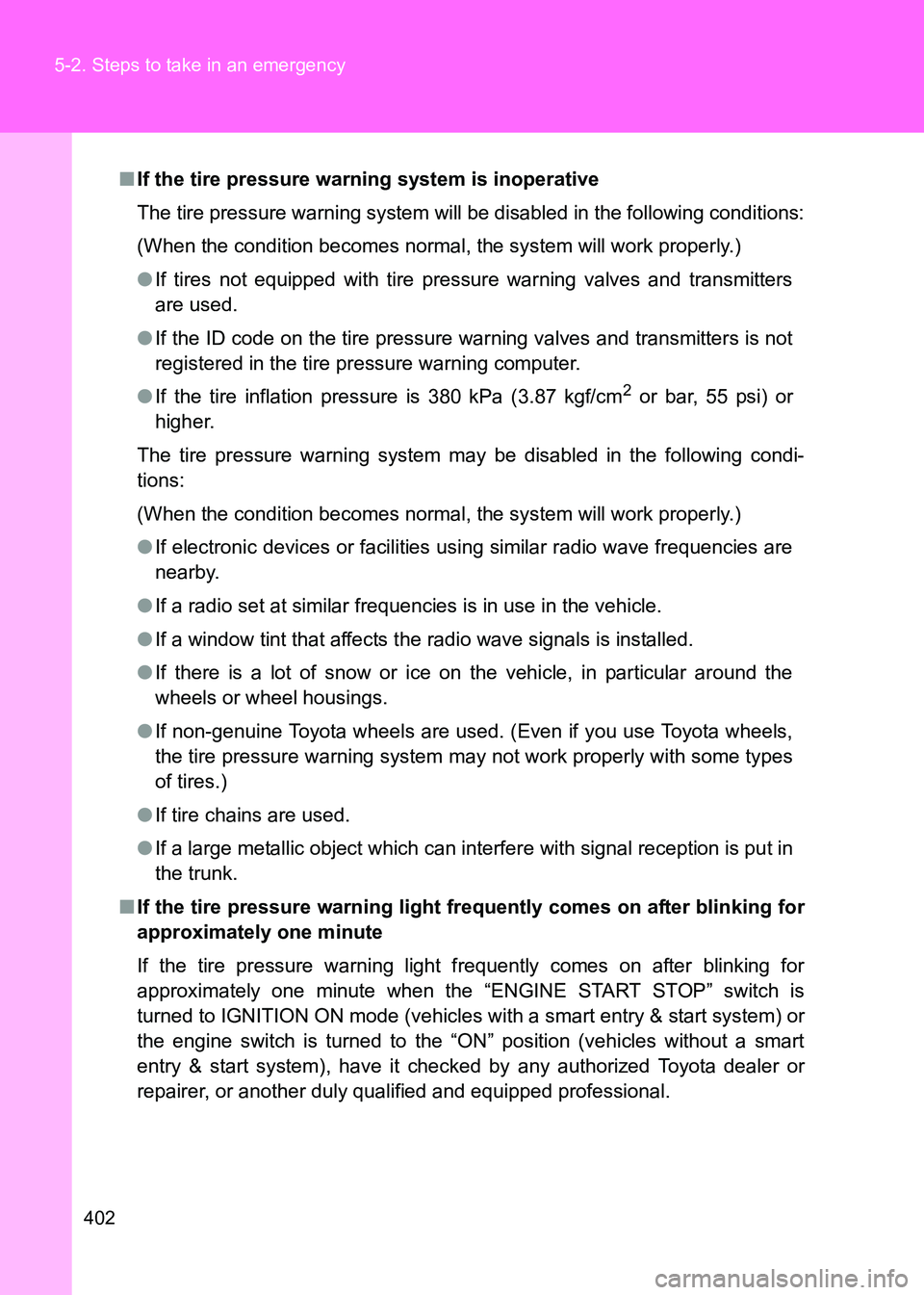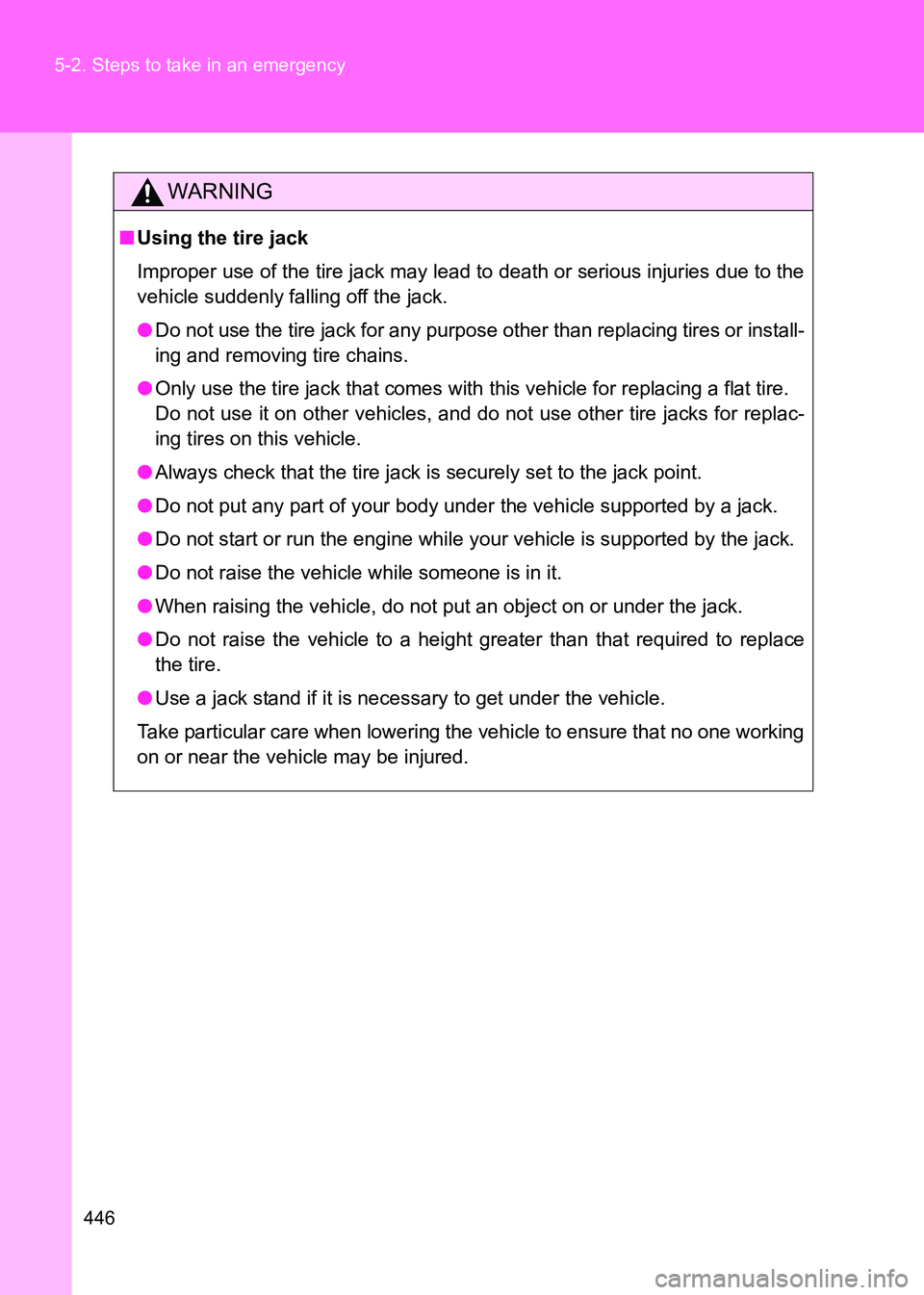Page 402 of 505

402
5-2. Steps to take in an emergency
86_EE (OM18071E)
■
If the tire pressure warning system is inoperative
The tire pressure warning system will be disabled in the following conditions:
(When the condition becomes normal, the system will work properly.)
● If tires not equipped with tire pressure warning valves and transmitters
are used.
● If the ID code on the tire pressure warning valves and transmitters is not
registered in the tire pressure warning computer.
● If the tire inflation pressure is 380 kPa (3.87 kgf/cm
2 or bar, 55 psi) or
higher.
The tire pressure warning system may be disabled in the following condi-
tions:
(When the condition becomes normal, the system will work properly.)
● If electronic devices or facilities using similar radio wave frequencies are
nearby.
● If a radio set at similar frequencies is in use in the vehicle.
● If a window tint that affects t he radio wave signals is installed.
● If there is a lot of snow or ice on the vehicle, in particular around the
wheels or wheel housings.
● If non-genuine Toyota wheels are used. (Even if you use Toyota wheels,
the tire pressure warning system may not work properly with some types
of tires.)
● If tire chains are used.
● If a large metallic object which can interfere with signal reception is put in
the trunk.
■ If the tire pressure warning light frequently comes on after blinking for
approximately one minute
If the tire pressure warning light frequently comes on after blinking for
approximately one minute when the “ENGINE START STOP” switch is
turned to IGNITION ON mode (vehicles with a smart entry & start system) or
the engine switch is turned to the “ON” position (vehicles without a smart
entry & start system), have it checked by any authorized Toyota dealer or
repairer, or another duly qualified and equipped professional.
Page 411 of 505
5
411
5-2. Steps to take in an emergency
When trouble arises
86_EE (OM18071E)
Have the malfunction repaired immediately.
After taking the specified steps to correct the suspected problem,
check that the warning message and light go off.
InteriorbuzzerExterior
buzzerWarning messageDetailsCorrection procedure
Once
(Flashes)
(Flashes in yellow)
Indicates that the
electronic key is
not present when
attempting to
start the engine. Confirm
the loca-
tion of the
electronic
key.
Once
3 times
(Flashes)
(Flashes in yellow)
Indicates that a
door other than
the driver’s door
has been opened
and closed with
the “ENGINE
START STOP”
switch in any
mode other than
off and the elec-
tronic key out-
side of the
detection area. Confirm
the loca-
tion of the
electronic
key.
Page 423 of 505
5
423
5-2. Steps to take in an emergency
When trouble arises
86_EE (OM18071E)
■
Before repairing the tire
●Stop the vehicle in a safe place on a hard, flat surface.
● Set the parking brake.
● Shift the shift lever to P (vehicles with an automatic transmis-
sion) or N (vehicles with a manual transmission).
● Stop the engine.
● Turn on the emergency flashers. ( →P. 384)
● Check the degree of the tire
damage.
• Do not remove the nail or
screw from the tire.
Removing the object may
widen the opening and
prevent emergency repair
with the repair kit.
• To avoid sealant leakage,
move the vehicle until the
area of the puncture, if
known, is positioned at
the top of the tire.
Page 429 of 505
5
429
5-2. Steps to take in an emergency
When trouble arises
86_EE (OM18071E)
Connect the compressor power
plug to the power outlet.
Vehicles without a smart entry &
start system: The engine switch
must be in the “ACC” position.
Vehicles with a smart entry & start
system: The “ENGINE START
STOP” switch must be in ACCES-
SORY mode.
Connect the air compressor
hose by threading it on the valve.
Left-hand drive vehicles: Check
the specified inflation pressure.
The label is placed as shown in
the illustration.
Right-hand drive vehicles: Check
the specified inflation pressure.
The label is placed as shown in
the illustration.
Power
outlet
STEP12Power plug
STEP13
CompressorHose
STEP14
STEP14
Page 446 of 505

446
5-2. Steps to take in an emergency
86_EE (OM18071E)
WARNING
■
Using the tire jack
Improper use of the tire jack may lead to death or serious injuries due to the
vehicle suddenly falling off the jack.
●Do not use the tire jack for any purpose other than replacing tires or install-
ing and removing tire chains.
● Only use the tire jack that comes with this vehicle for replacing a flat tire.
Do not use it on other vehicles, and do not use other tire jacks for replac-
ing tires on this vehicle.
● Always check that the tire jack is securely set to the jack point.
● Do not put any part of your body under the vehicle supported by a jack.
● Do not start or run the engine while your vehicle is supported by the jack.
● Do not raise the vehicle while someone is in it.
● When raising the vehicle, do not put an object on or under the jack.
● Do not raise the vehicle to a height greater than that required to replace
the tire.
● Use a jack stand if it is necessary to get under the vehicle.
Take particular care when lowering the vehicle to ensure that no one working
on or near the vehicle may be injured.
Page 451 of 505

5
451
5-2. Steps to take in an emergency
When trouble arises
86_EE (OM18071E)
Emergency start function (vehicles with a smart entry & start system)
When the engine does not start, the following steps can be used as
an interim measure to start the engine if the “ENGINE START STOP”
switch is functioning normally:
Vehicles with an automatic transmission
Set the parking brake.
Put the shift lever in P.
Set the “ENGINE START STOP” switch to ACCESSORY
mode.
Press and hold the “ENGINE START STOP” switch about 15
seconds while depressing the brake pedal firmly.
Even if the engine can be started using the above steps, the system
may be malfunctioning. Have the vehicle checked by any authorized
Toyota dealer or repairer, or another duly qualified and equipped pro-
fessional.
■ The starter motor does not turn over, the interior lights and
headlights do not turn on, or the horn does not sound.
One of the following may be the cause of the problem.
●One or both of the battery terminals may be disconnected.
● The battery may be discharged. ( →P. 459)
● There may be a malfunction in the steering lock system. (vehi-
cles with a smart entry & start system)
Contact any authorized Toyota dealer or repairer, or another duly
qualified and equipped professional if the problem cannot be
repaired, or if repair procedures are unknown.
STEP 1
STEP 2
STEP 3
STEP 4
Page 452 of 505
452
5-2. Steps to take in an emergency
86_EE (OM18071E)
Vehicles with a manual transmission
Set the parking brake.
Put the shift lever in N.
Turn the “ENGINE START STOP” switch to ACCESSORY
mode.
Push and hold the “ENGINE START STOP” switch for about
15 seconds while depressing the brake pedal and clutch
pedal firmly.
Even if the engine can be started using the above steps, the system
may be malfunctioning. Have the vehicle checked by any authorized
Toyota dealer or repairer, or another duly qualified and equipped pro-
fessional.
STEP 1
STEP2
STEP 3
STEP 4
Page 456 of 505
456
5-2. Steps to take in an emergency
86_EE (OM18071E)
Starting the engine
Vehicles with an automatic transmission Ensure that the shift lever is in P and firmly depress the brake
pedal.
Touch the Toyota emblem side of
the electronic key to the
“ENGINE START STOP” switch.
When the electronic key is
detected, a buzzer sounds and
the “ENGINE START STOP”
switch will turn to IGNITION ON
mode.
When the smart entry & start sys-
tem is deactivated in customiza-
tion setting, the “ENGINE START
STOP” switch will turn to ACCES-
SORY mode.
Firmly depress the brake pedal and check that the smart entry
& start system indicator light (green) turns on.
Press the “ENGINE START STOP” switch.
In the event that the “ENGINE START STOP” switch still cannot be
operated, contact any authorized Toyota dealer or repairer, or another
duly qualified and equipped professional.
STEP 1
STEP 2
STEP 3
STEP 4